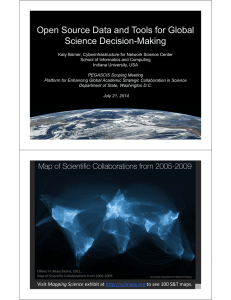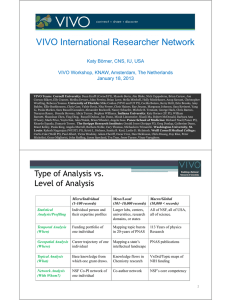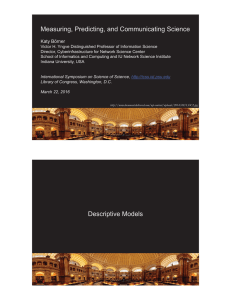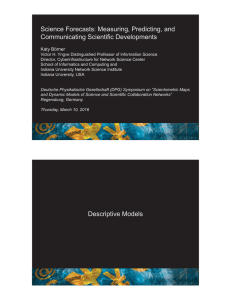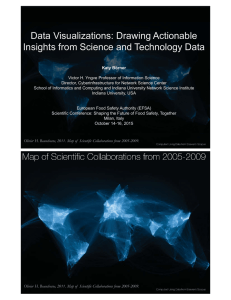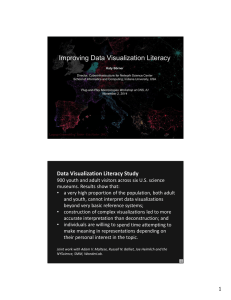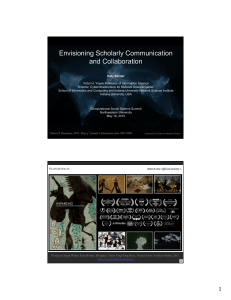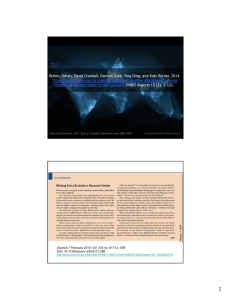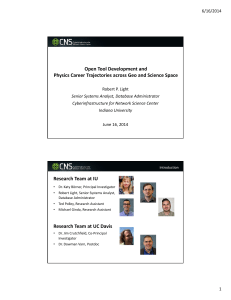Networks, Collaborations, and Emerging Fields
advertisement
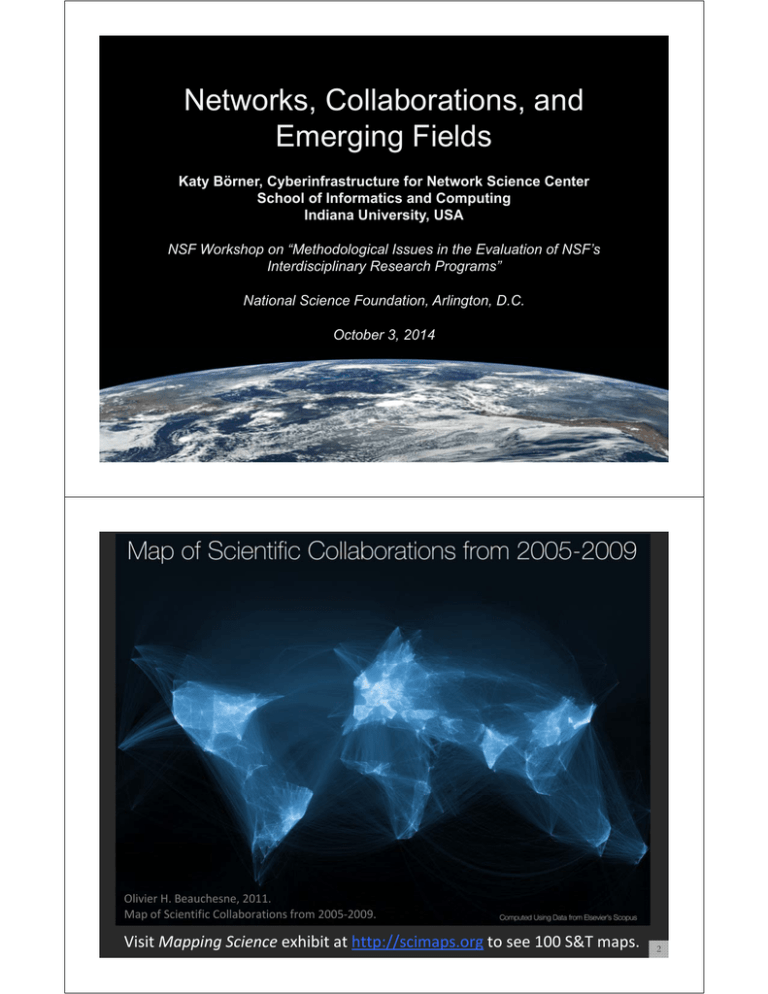
Networks, Collaborations, and Emerging Fields Katy Börner, Cyberinfrastructure for Network Science Center School of Informatics and Computing Indiana University, USA NSF Workshop on “Methodological Issues in the Evaluation of NSF’s Interdisciplinary Research Programs” National Science Foundation, Arlington, D.C. October 3, 2014 Olivier H. Beauchesne, 2011. Map of Scientific Collaborations from 2005‐2009. Visit Mapping Science exhibit at http://scimaps.org to see 100 S&T maps. 2 Science Maps in “Expedition Zukunft” science train visited 62 cities in 7 months. Opening was on April 23rd, 2009 by German Chancellor Merkel 3 LinkedIn: World's Largest Professional Network https://www.linkedin.com Launched in May 2003. More than 225 million users in June 2013. Exemplary Expert Networking Service 4 ResearchGate GmbH https://www.researchgate.net Launched in May 2008, has a user base of 2.3 million scientists worldwide in Aug .2013 Exemplary Expert Networking Service 5 Academia.edu—Share Research http://www.academia.edu Launched in Nov 2010. Exemplary Expert Networking Service 6 Google Scholar http://scholar.google.com Launched in Nov. 2011. Has “unknown” number of profiles. Exemplary Expert Networking Service 7 http://nrn.cns.iu.edu Light, Robert, Chin Hua Kong, and Katy Börner. 2013. "An Automated System for Tracking the Growth of Expert Profiling Systems". Joint Conference on Digital Libraries (JCDL). 8 Open Data: Linked Data, 2011 http://lod‐cloud.net 9 Expert Networking Services—60 More http://en.wikipedia.org/wiki/Comparison_of_Research_Networking_Tools_and_Research_Profiling_Systems 10 Example: Identifying (and Evaluating) ‘Microbiome’ Research Using existing systems to identify expertise on ‘Microbiome’ • CTSA DIRECT2Experts a pilot national network to demonstrate interoperability among research‐networking platforms: http://direct2experts.org • NSF Award Search: http://www.nsf.gov/awardsearch • NIH Reporter: http://projectreporter.nih.gov • European Commission CORDIS FP7 data: http://cordis.europa.eu/fp7/projects_en. html http://academy.asm.org/images/stories/ documents/FAQ_Human_Microbiome.pdf To support • Foresight + Context • LOCAL Strategic Decision Making • GLOBAL Networks and Insight 12 808 experts found 13 14 Inter‐Institutional Collaboration Explorer This visualization shows information about “collaborative publications” found at 2 or more Researcher Networking websites. The idea that institutions don't work together and that biomedical research is conducted in silos is not true. Researchers, even when separated by great distances, are in fact willing to work together, and this visualization demonstrates that they often do. Contact: Nick Benik (nbenik@gmail.com), Harvard Medical School, Boston, MA. URL: http://xcite.hackerceo.org/VIVOviz 15 Inter‐Institutional Collaboration Explorer The outer solid colored arcs represent the 11 institutions. The size of the arc is proportional to the number of collaborative publications found on the site. The inner colored bands represent the number of collaborative publications found between the two institutions that each band connects. Clicking an institution's arc will hide any bands not connected to that institution and will display a timeline of when that institution's collaborative publications were written. 16 17 69 NSF projects found. They were awarded to 53 unique institutions. 18 69 NSF projects found. They were awarded to 53 unique institutions. 19 537 NIH awards found on 7/19/2014. 544 NIH awards found on 7/20/2014. Omitted 34 records with missing values. 20 21 U.S map and world map of #projects per geolocation. 22 1,406 projects with 4,326 participating countries (96 unique) found 23 European Commission 24 http://nrn.cns.iu.edu Light, Robert, Chin Hua Kong, and Katy Börner. 2013. "An Automated System for Tracking the Growth of Expert Profiling Systems". Joint Conference on Digital Libraries (JCDL). 25 Co‐authorship network for the department of Information Systems Source: Melbourne Research Windows. Contact Simon Porter simon.porter@unimelb.edu.au 26 Search term Researcher Bimodal network of search terms and researchers extracted from research profile search results to show the University’s capability in Disaster Management to the Government Contact: simon.porter@unimelb.edu.au 27 http://nrn.cns.iu.edu Light, Robert, Chin Hua Kong, and Katy Börner. 2013. "An Automated System for Tracking the Growth of Expert Profiling Systems". Joint Conference on Digital Libraries (JCDL). 28 Top MeSH Disease Concepts Appearing in PubMed Publications by the University of Michigan Medical School. Links connect concepts where 100+ authors published about both concepts within the span of their careers. Contact: Jeffrey Horon, J.Horon@elsevier.com Top MeSH Disease Concepts Appearing in PubMed Publications by the University of Michigan Medical School. Links connect concepts where 100+ authors published about both concepts within the span of their careers. This visualization revealed that animal disease models were central to disease research at U‐M which encouraged additional thought and attention to animal husbandry, animal expenses, and core/shared services overall. Contact: Jeffrey Horon, J.Horon@elsevier.com 29 30 P30 Member Collaborations – Sponsored Project Co‐Participation and Co‐Authorship Network. Used in successful! P30 funding application. Shows the PI’s relationships with various P30 members, conveying that the PI was not only the formal center of the group but also the informal center and the person who exhibited the highest betweenness centrality. Contact: Jeffrey Horon, J.Horon@elsevier.com 31 http://nrn.cns.iu.edu Light, Robert, Chin Hua Kong, and Katy Börner. 2013. "An Automated System for Tracking the Growth of Expert Profiling Systems". Joint Conference on Digital Libraries (JCDL). 32 33 34 Make sure to register your institution’s researcher networking system at http://nrn.cns.iu.edu 35 Example: Evaluating Interdisciplinary Research Measuring Interdisciplinary Scientific Research Wagner, Caroline, J. David Roessner, Kamau Bobb, Julie Thompson Klein, Kevin W. Boyack, Joann Keyton, Ismael Rafols, and Katy Börner. 2011. "Approaches to understanding and measuring interdisciplinary scientific research (IDR): A review of the literature". Journal of Informetrics 5(1): 14‐26. Type of Interdisciplinary Input Process Interdisciplinarity Interdisciplinarity Output Interdisciplinarity How Measured What expertise References are cited Etc. #Papers, citations products, new expertise Etc. Shared expertise data, methods, tools Etc. Types of Analysis and Visualization 38 Mapping Transdisciplinary Tobacco Use Research Centers Publications Compare R01 investigator based funding with TTURC Center awards in terms of number of publications and evolving co‐author networks. Stipelman, Hall, Zoss, Okamoto , Stokols & Börner, 2014 Supported by NIH/NCI Contract HHSN261200800812 39 All papers, maps, tools, talks, press are linked from http://cns.iu.edu These slides will soon be at http://cns.iu.edu/docs/presentations CNS Facebook: http://www.facebook.com/cnscenter Mapping Science Exhibit Facebook: http://www.facebook.com/mappingscience 40
